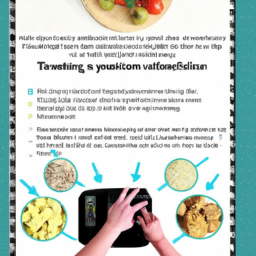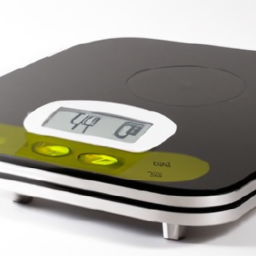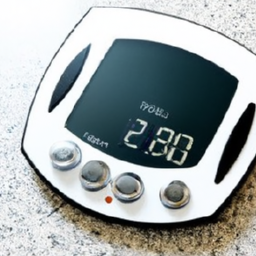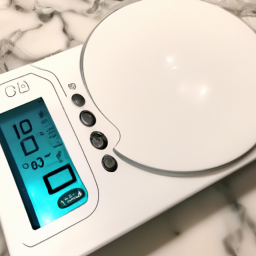How Do I Troubleshoot Common Issues With Smart Kitchen Scales
If you’ve recently acquired a smart kitchen scale and are experiencing some hiccups, fret not! This article will guide you through troubleshooting common issues with smart kitchen scales. Whether you’re struggling with inaccurate measurements or connectivity problems, we’ve got you covered. By following the steps outlined in this guide, you’ll be back to measuring ingredients with ease in no time.
Understanding Smart Kitchen Scales
Smart kitchen scales are innovative and convenient tools that can greatly enhance your cooking and baking experience. These scales offer a wide range of features designed to make measuring ingredients more accurate and efficient. By understanding the key features and inner workings of smart kitchen scales, you can troubleshoot common issues that may arise and ensure seamless operation in your kitchen.
Key Features of Smart Kitchen Scales
Smart kitchen scales come equipped with a variety of features that set them apart from traditional scales. These features include:
-
Precision: Smart kitchen scales offer precise measurements, often to the gram or ounce, allowing for greater accuracy in recipes.
-
Tare Function: The tare function enables you to place a container on the scale and reset it to zero, allowing you to measure only the weight of the ingredients you add.
-
Unit Conversion: Many smart kitchen scales allow you to switch between different units of measurement, such as grams, pounds, or milliliters, to accommodate various recipes.
-
Connectivity: Smart kitchen scales can connect to your smartphone or tablet via Bluetooth or Wi-Fi, allowing for seamless integration with recipe apps and the ability to track your measurements and progress.
-
Sleek Design: These scales often boast sleek and modern designs that can enhance the aesthetic appeal of your kitchen.
How Smart Kitchen Scales Work
Smart kitchen scales utilize advanced technology to accurately measure the weight of ingredients. They typically have load cells or strain gauges built into their surface, which detect the amount of force applied to the scale when an ingredient is placed on top.
When you place an item on the scale, the load cells or strain gauges measure the amount of force applied and convert it into an electrical signal. This signal is then processed by the scale’s internal circuitry, which calculates the weight based on the signal received.
Many smart kitchen scales have a digital display that shows the weight measurement in real time. Some models also have additional features, such as touch-sensitive buttons and built-in timers, further enhancing their functionality.
General Troubleshooting Steps
If you encounter any issues with your smart kitchen scale, there are some general troubleshooting steps you can take to resolve them. These steps can help address common problems and ensure smooth operation of your scale.
Power Cycle the Scale
One of the first steps to troubleshoot any electronic device is to perform a power cycle. To power cycle your smart kitchen scale, simply turn it off and unplug it from the power source. Wait for a few minutes before plugging it back in and turning it on again. This can help reset the scale’s internal system and resolve any temporary glitches or errors.
Check if the Scale is on a Flat Surface
Ensure that your smart kitchen scale is placed on a flat, stable surface. Uneven or unstable surfaces can cause inaccurate readings or hinder the scale’s functionality. If necessary, relocate the scale to a more suitable surface and check if the issue persists.
Reset the Scale
If you’re experiencing persistent issues with your smart kitchen scale, you may want to try resetting it to its factory settings. Refer to the user manual or manufacturer’s instructions on how to perform a factory reset. Keep in mind that this will delete any customized settings or data stored on the scale, so proceed with caution.
Update the Scale’s Firmware
Like many electronic devices, smart kitchen scales may require firmware updates to ensure optimal performance. Check the manufacturer’s website or the scale’s companion app for any available firmware updates. Follow the instructions provided to download and install the updates onto your scale.
Check the Scale’s Connectivity
If your smart kitchen scale has Bluetooth or Wi-Fi capabilities, ensure that it is properly connected to your smartphone, tablet, or other devices. Check the settings on both the scale and the companion app to ensure they are properly paired. If you’re experiencing connectivity issues, try turning off and on the scale’s Bluetooth or Wi-Fi feature or restarting the companion app.
By following these general troubleshooting steps, you can address common issues that may arise with your smart kitchen scale. However, if you continue to experience problems, it’s important to delve deeper into specific categories of issues to pinpoint and resolve the root cause.
Power-related Issues
Power-related issues can disrupt the operation of your smart kitchen scale and hinder your cooking and baking endeavors. If you encounter any power-related problems, consider the following troubleshooting steps.
Scale Won’t Turn On
If your smart kitchen scale fails to turn on, the first thing to check is the power source. Ensure that the scale is properly plugged into a working electrical outlet or that the batteries are correctly inserted. If you’re using batteries, check if they are depleted or inserted incorrectly. Replace the batteries or insert them in the proper orientation, and try turning on the scale again.
Scale Turns Off Unexpectedly
If your smart kitchen scale powers off unexpectedly during use, it may be experiencing power supply issues. Make sure that the power source is stable and reliable. If you’re using batteries, ensure that they are properly inserted and have sufficient charge. If your scale is powered by an electrical outlet, check if the power cord is securely connected. If these steps do not resolve the issue, it may be necessary to seek assistance from customer support or consult the manufacturer’s troubleshooting resources.
Issues with Battery or Power Supply
If your smart kitchen scale relies on batteries for power, it’s important to consider the condition of the batteries. Check if they are depleted or low on charge and replace them as necessary. If you’re using rechargeable batteries, ensure that they are fully charged before using the scale. In the case of a scale powered via an electrical outlet, verify that the power supply is stable and the cord is not damaged or frayed.
Low Battery Warnings
Some smart kitchen scales provide low battery warnings when the battery charge is running low. If you receive a low battery warning, take prompt action to replace or recharge the batteries. Failing to do so may result in unexpected power loss and interruption of scale operation.
By addressing power-related issues, you can ensure that your smart kitchen scale is functioning optimally and providing accurate measurements. However, if you encounter problems specifically related to weight measurements, it’s important to troubleshoot them accordingly.
Problems with Weight Measurements
Accurate weight measurements are crucial when using a smart kitchen scale for precise cooking and baking. If you notice any inconsistencies or issues with weight measurements, consider the following troubleshooting steps.
Inaccurate Weight Measurements
If your smart kitchen scale consistently provides inaccurate weight measurements, it may require calibration. Refer to the user manual or manufacturer’s instructions on how to calibrate your specific scale model. Calibration typically involves placing a known weight on the scale and adjusting it accordingly. Performing regular calibrations can help ensure the accuracy of your scale’s measurements.
Scale Fluctuates Between Weights
Receiving fluctuating weight measurements on your smart kitchen scale can be frustrating. To troubleshoot this issue, ensure that the scale is placed on a stable surface and that there are no external factors causing vibrations or disturbances. It’s also important to verify that the scale’s load cells or strain gauges are clean and free from any debris or obstruction. Cleaning the surface of the scale and removing any potential hindrances may resolve the issue.
Scale Doesn’t Register Weight at All
If your smart kitchen scale fails to register any weight, it may be due to various reasons. Check the power source and ensure that the scale is properly turned on and connected. If the issue persists, see if the scale’s surface is clean and free from any residue or moisture that may be interfering with its functionality. Additionally, inspect the scale’s load cells or strain gauges for any damage or signs of wear. If these troubleshooting steps do not resolve the issue, it may be necessary to seek further assistance from customer support or refer to the manufacturer’s resources.
By troubleshooting problems related to weight measurements, you can ensure the accuracy and reliability of your smart kitchen scale. However, if you encounter issues with connectivity, it’s paramount to address them effectively to utilize the full potential of your scale’s smart features.
Connectivity Issues
Connectivity issues can hinder the seamless integration of your smart kitchen scale with other devices, such as smartphones or tablets. If you encounter any connectivity-related problems, consider the following troubleshooting steps.
Troubles Connecting to WiFi or Bluetooth
If your smart kitchen scale is unable to connect to your Wi-Fi network or Bluetooth device, ensure that you are within the range of the network or device. Check if the scale’s connectivity feature is turned on and properly configured. Verify that the network or device you are trying to connect to is operational and supports the scale’s connectivity requirements. If necessary, restart the scale or the device you are trying to connect with and try again.
Interruptions in Data Transfer
Data transfer interruptions can occur when syncing your smart kitchen scale with your smartphone or tablet. To troubleshoot this issue, ensure that both the scale and the companion app have the latest firmware updates installed. Additionally, verify that your device has a stable internet connection, as interruptions in connectivity can disrupt data transfer. If the problem persists, try resetting the scale or reinstalling the companion app.
Issues Syncing with Smartphones or Tablets
If your smart kitchen scale fails to sync with your smartphone or tablet, consider checking the compatibility between the two devices. Ensure that the scale and the device meet the necessary system requirements to establish a successful connection. Confirm that the companion app is properly installed and authorized to access the scale’s data. If you’re still experiencing issues, refer to the manufacturer’s troubleshooting resources or contact customer support for assistance.
By troubleshooting connectivity issues, you can ensure that your smart kitchen scale seamlessly integrates with your other devices, enabling you to harness its full potential. However, if you encounter issues specifically related to the companion app, it’s important to address them promptly to maximize the app’s functionality.
Issues with the Companion App
The companion app plays a vital role in maximizing the features and capabilities of your smart kitchen scale. If you encounter any problems with the app, consider the following troubleshooting steps.
App Crashes or Freezes
If your smart kitchen scale’s companion app crashes or freezes during use, try closing the app completely and reopening it. Additionally, ensure that you have the latest version of the app installed on your device, as updates often contain bug fixes and performance improvements. If the problem persists, consider restarting your device or reinstalling the app.
Connectivity Problems Between App and Scale
If you’re experiencing connectivity problems between the companion app and the smart kitchen scale, ensure that both the scale and the app are properly connected. Verify that the Bluetooth or Wi-Fi feature is turned on and that the scale is within the range of your device. If necessary, turn off and on both the scale and the device’s connectivity features or restart the app.
Troubles Logging in to the App
If you’re having trouble logging in to your smart kitchen scale’s companion app, double-check that you are using the correct username and password or authentication method. Verify that your device has a stable internet connection during the login process, as poor connectivity can prevent successful authentication. If you have forgotten your login credentials, follow the app’s password recovery or account retrieval procedures.
Problems with the App’s Data Tracking or Reporting
If the companion app fails to track or report data accurately, ensure that all necessary permissions are granted for the app to access relevant data on your device. Check if the scale and the app are properly synced and that the scale’s measurements are being transferred to the app correctly. It’s also important to ensure that you are using the app as intended, following the provided instructions and guidelines.
By troubleshooting issues with the companion app, you can fully leverage the features and capabilities of your smart kitchen scale. However, if you encounter difficulties during firmware updates, it’s crucial to address them appropriately to enhance the overall performance of your scale.
Troubles with Firmware Updates
Firmware updates are essential for maintaining the optimal performance and functionality of your smart kitchen scale. If you encounter any problems during firmware updates, consider the following troubleshooting steps.
Firmware Update Fails to Install
If a firmware update fails to install on your smart kitchen scale, ensure that you are following the provided instructions correctly. Verify that the update file you downloaded is compatible with your specific scale model. If the update process encounters an error or fails to complete, try restarting the scale and reattempting the update. If the issue persists, refer to the manufacturer’s troubleshooting resources or contact customer support for further assistance.
Issues After a Firmware Update
If you experience issues with your smart kitchen scale after a firmware update, consider performing a power cycle on the scale. This can help reset the internal system and ensure proper initialization after the update. It’s also essential to ensure that both the scale and the companion app are running the latest firmware versions. If you continue to encounter problems, consult the manufacturer’s troubleshooting resources or seek assistance from customer support.
Unable to Check for New Firmware
If you’re unable to check for new firmware updates on your smart kitchen scale, ensure that the scale is properly connected to the internet. Verify that the scale’s Wi-Fi or Bluetooth feature is enabled and that the connection is stable. If your scale uses a companion app for firmware updates, check if the app has permission to access the internet. If the issue persists, it may be necessary to verify the manufacturer’s website or contact customer support for assistance.
By troubleshooting firmware update issues, you can ensure that your smart kitchen scale remains up to date and benefits from the latest features and improvements. However, if you encounter problems with the physical components of the scale itself, it’s crucial to address them promptly to ensure smooth and accurate operation.
Problems with Physical Components
Physical component issues can significantly impact the functionality and usability of your smart kitchen scale. If you encounter any problems related to the physical components, consider the following troubleshooting steps.
Scale Surface is Unresponsive or Slow to Respond
If the surface of your smart kitchen scale is unresponsive or slow to respond to touch, ensure that it is clean and free from any debris or moisture. Wipe the surface with a soft, dry cloth to remove any potential obstructions. If the issue persists, try restarting the scale or performing a power cycle. If the problem continues, it may be necessary to seek further assistance from customer support or consult the manufacturer’s troubleshooting resources.
Buttons Don’t Work
If the buttons on your smart kitchen scale do not work, check if they are properly aligned and not stuck. Gently press each button to ensure that it depresses and releases smoothly. If the buttons still do not function, try cleaning the surface surrounding the buttons to remove any dirt or residue that may be hindering their operation. If these steps do not resolve the issue, contact customer support for further assistance.
Screen is Blank or Dark
If the screen of your smart kitchen scale is blank or appears dark, ensure that the scale has sufficient power supply. Check if the scale is turned on and connected to the power source or if the batteries are correctly inserted and charged. If the issue persists, try adjusting the brightness settings on the scale, if applicable. If the screen remains unresponsive, it may indicate a hardware problem, and further assistance from customer support or the manufacturer may be necessary.
Issues with Ports or Connectors
If you encounter issues with the ports or connectors on your smart kitchen scale, ensure that they are clean and free from any debris or damage. Inspect the ports and connectors for any signs of wear or looseness. If necessary, clean the ports with compressed air or a soft brush. If the problem continues, consult the manufacturer’s troubleshooting resources or contact customer support for further guidance.
By troubleshooting problems with the physical components of your smart kitchen scale, you can ensure its longevity and reliable performance. However, if issues arise during set-up and calibration, it’s essential to address them promptly to optimize the scale’s functionality.
Issues with Set-up and Calibration
Set-up and calibration are crucial steps when integrating a smart kitchen scale into your cooking routine. If you encounter any problems during set-up or calibration, consider the following troubleshooting steps.
Trouble Setting Up the Scale for First-time Use
If you are having difficulty setting up your smart kitchen scale for first-time use, ensure that you are following the provided instructions correctly. Check if all necessary components are included and intact. Ensure that the scale is properly connected to a power source or that the batteries are correctly inserted. If the scale requires a companion app, follow the app’s instructions for initial set-up. If you continue to experience difficulties, refer to the manufacturer’s troubleshooting resources or seek assistance from customer support.
Issues Calibrating the Scale
If you’re experiencing issues during the calibration process of your smart kitchen scale, refer to the user manual or manufacturer’s instructions for specific calibration procedures. Ensure that you are using a known weight or reference item to calibrate the scale accurately. Double-check each step of the calibration process, making sure to follow the instructions precisely. If the scale still fails to calibrate properly, it may be necessary to consult the manufacturer’s troubleshooting resources or contact customer support.
Difficulty Changing Weight Units
If you’re having trouble changing weight units on your smart kitchen scale, refer to the user manual or manufacturer’s instructions for guidance. Follow the specified steps to switch between weight units, ensuring that you press the correct buttons or adjust the appropriate settings. If the scale does not respond or the weight units do not change as expected, try resetting the scale to its factory settings and attempt the process again. If the issue persists, consult the manufacturer’s troubleshooting resources or reach out to customer support.
Re-calibrating After a Move or Relocation
If you have recently moved or relocated your smart kitchen scale, it may be necessary to recalibrate it to ensure accurate measurements. Follow the calibration instructions provided in the user manual or by the manufacturer, using a known weight or reference item. Perform the calibration process on a stable surface, free from any vibrations or disturbances. If the scale still does not calibrate correctly after following the instructions, consult the manufacturer’s troubleshooting resources or contact customer support for further assistance.
By troubleshooting set-up and calibration problems, you can ensure that your smart kitchen scale is accurately calibrated and ready to provide precise measurements. However, if you require additional support or information, it’s important to know where to turn for service and assistance.
Service and Support Resources
Having access to service and support resources is essential when troubleshooting and resolving issues with your smart kitchen scale. Consider the following resources for assistance.
Contacts for Customer Support
Refer to the user manual or the manufacturer’s website for contact information regarding customer support. It may include phone numbers, email addresses, or online chat options. Reach out to customer support with any specific issues or questions you have regarding your smart kitchen scale.
Online Resources for Troubleshooting
Manufacturers often provide online troubleshooting resources, including FAQs, knowledge bases, forums, and video tutorials. Visit the manufacturer’s website to access these resources and find answers to common issues. These online platforms can offer valuable guidance and step-by-step instructions for resolving problems with your smart kitchen scale.
Warranty and Repair Information
Review the warranty information provided with your smart kitchen scale to understand the coverage and duration of the warranty. If your scale experiences a malfunction or requires repair within the warranty period, contact the manufacturer to initiate the repair process. Follow the provided instructions for warranty claims, repair services, or replacement options.
When to Consider Replacing Your Smart Kitchen Scale
If you have exhausted all troubleshooting options and your smart kitchen scale continues to exhibit persistent issues, you may need to consider replacing it. Contact the manufacturer or consult the warranty information for guidance on replacement options or upgrading to a newer model. Explore reputable retailers or online marketplaces for purchasing a compatible replacement and ensure that the new scale meets your specific needs and expectations.
By utilizing service and support resources, you can find the necessary assistance to troubleshoot and resolve issues with your smart kitchen scale. However, understanding common problems and their troubleshooting steps can help prevent issues from occurring in the first place, leading to a more enjoyable and efficient cooking experience. With the right knowledge and troubleshooting techniques, you can make the most of your smart kitchen scale and elevate your culinary creations.







